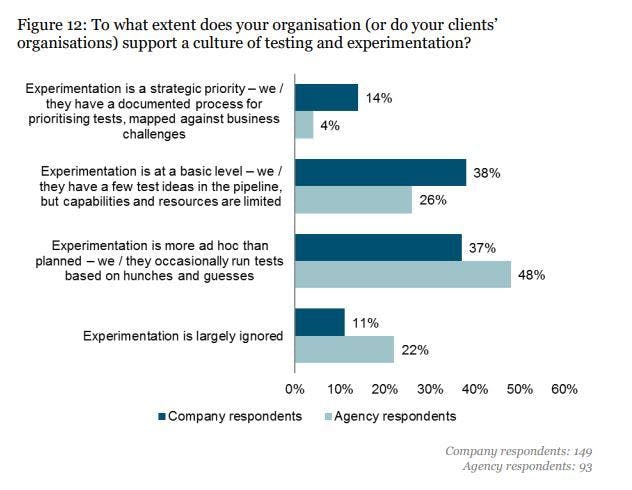But are ecommerce marketers reaching experimentation maturity? Here are a few key charts from the report, with further insight into what they tell us.
Striving for advancements in strategy
With 78% of companies surveyed reporting that their ecommerce revenues have grown in the past 12 months, it’s clear that the market is buoyant.
So, is this due to advances in strategy? Not necessarily, as it appears there are strides still to make. While 43% of respondents say their organisations’ ecommerce strategy ‘quite advanced’ and 11% consider it ‘very’ advanced, 46% of companies still rate themselves as either ‘not very advanced’ or ‘immature’.
Meanwhile, many businesses are struggling to break out of a siloed organisational structure, whereby information about online customer behaviour is not freely available to offline departments.
There also appears to be a lack of insight into the barriers to conversion. Just 15% of company respondents say they have an accurate idea of how much online revenue is lost through site abandonment due to a poor user experience.

Gaps between expectations and reality of experimentation
56% of respondents rate the impact of experimentation as ‘high’ or ‘very high’, with the majority clearly willing to acknowledge it as a key business enabler.
Despite this, however, many respondents who understand the advantages have not yet taken steps to put it into practice.
This could be because organisations have not yet reached maturity in ecommerce optimisation. However, it largely appears due to organisations failing to even address the practicalities required – i.e. resources, capabilities, and financial backing. Just 14% of companies describe experimentation as a strategic priority, meaning they have a documented and structured approach to testing.

How marketers are tackling experimentation
So, what tools are companies using for experimentation?
The research shows that many organisations are restricted in terms of the volume of experimentation they conduct, as well as relatively low levels of sophistication in the experiments ran. As a result, companies are often basing their ecommerce decisions on limited or incomplete data.
The analysis of customer feedback is the most widely-used technique for improving ecommerce performance (81% of company respondents and 70% of agencies). A/B testing is similarly commonplace. In contrast, usability testing is relatively under-used, as are expert usability reviews, and multivariate testing.

Plans for future experimentation
When asked about plans for experimentation in relation to technological and consumer trends, 59% of companies said they are planning for conversational commerce – i.e. messaging apps and chatbots.
Next, 55% of companies said they will be experimenting with AI for personalisation, and 44% said digital payments. Perhaps somewhat surprisingly, just 18% are planning to experiment with voice technology, despite an apparent surge in consumer interest.

Overall, it’s clear that many organisations are still struggling to balance performance optimisation with the limitations they currently face, all the while striving to experiment in response to technological trends.
If we can gather anything from the current state of experimentation within organisations, it is that a strategic approach (rather than ad-hoc testing) will be the first step on the road to success.

Comments